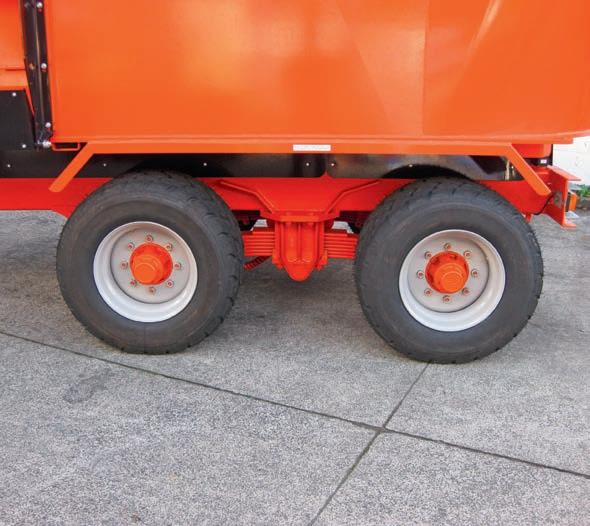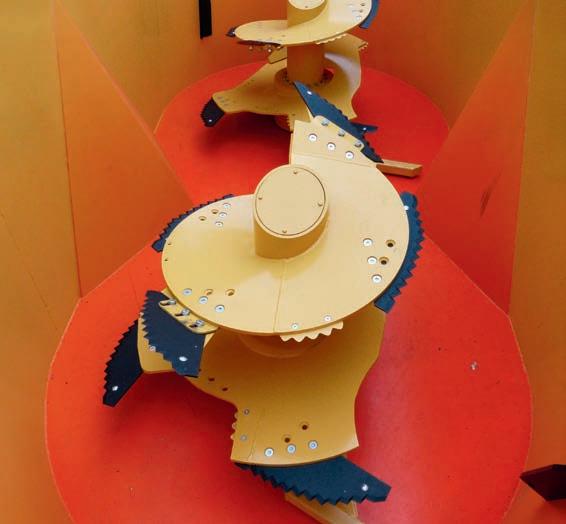
5 minute read
Cover Story: Abbey Machinery mixers
amazing graze
Ireland’s own Abbey Machinery offers single and twin auger vertical mixers that can handle heavy feed loads reliably and with minimal maintenance
Locally, one of the major positives of 2020 has been the breaking of a long-standing drought in parts of Queensland and New South Wales. The dry conditions had knock-on effects on total grain production and saw sales of hay balers increase strongly, as demand for fodder rose across the country. Russell Dalziel, the Australian business development manager for agricultural equipment importer Farmgard, says the same is true of mixer wagons, which experienced a surge in popularity at that time. “During the drought a lot of people were buying in feed, but then to get the best out of the feed they were mixing it up with other additives to get the best out of their animals – to give their animals the best chances of survival and growth,” he says. Dalziel adds that farmers wanting to feed their livestock – either taking on complete responsibility or supplementing available foods – should consult an animal nutritionist to ensure they were supplying the right things. “Mixers give them a mix of the right foods, proteins, fibres, etc. to get the best growth results,” he says. “There are guys who mix all sorts of things within the mixer. The base is obviously stray, hay and silage, but they will mix grains, they will mix molasses – all sorts of things like that.” Farmgard Pty Ltd, based in Truganina, Victoria, has imported feed mixers from Ireland’s Abbey Machinery range for about 15 years to both Australia and New Zealand. But, Dalziel says, in Australia the imports were previously done through a third party distribution arrangement in New South Wales. “But now we have expanded the operation to do it ourselves – and our target is to provide feeding solutions to all Australian farmers in every state and territory as required,” he says. Established by the Cavanagh family in 1947 and based in County Tipperary, Abbey Machinery is Ireland’s oldest agricultural machinery manufacturer – also producing slurry and muck handling and grassland management equipment. Its range of feed mixers is extensive – from single auger units with a 7 cubic metre capacity, to the 33 cubic metre capacity Tri-Auger VF3350. While all models are available for order in Australia, Dalziel says Farmgard targets two sizes of machines to maximise container space, thus reducing freight costs, which are in turn are handed on to the customer. These sizes include the single auger VF 1250 – with a capacity of 12 cubic metres – and a twin auger unit with a 20 cubic metre capacity, although a rubber extension takes it to 24 cubic metres. The two twin auger machines are available with either a front or side door discharge and a single or tandem axle, and all come standard with a fluted auger with 15mm auger flighting, which Dalziel says allows better distribution and mixing of the crop.

2

4 3
5

“The reason we use a fluted auger is that, in Australia, we traditionally use much lighter crops, so we use straw rather than silage and grain silage,” he says. “We use a fluted auger because it allows the lighter crops to fall down and get a better rotation – it allows the crop to move around the bowl a lot more efficiently and it makes a better mix without bubbling out the top.” All units are built with a 20mm-thick floor plate and 8mm-thick rolled steel side walls, to ensure the product is mixed thoroughly and smoothly. A set of adjustable counter knives is also a standard feature to reduce mix speed and ensure all feed is chopped more finely and mixed more thoroughly. “The actual mix is done by the shape of the auger, the positioning of the knives and the flow of the crop, which combines to make a very good mix,” Dalziel says. The twin auger models are fitted with two-speed gearboxes, which provide increased auger speed and torque. All models feature SOM planetary transmissions with low profile augers to reduce horsepower requirements and fuel use. Abbey also uses the Digi-Star EZ 3400 scales, with four weigh cells, which Dalziel says gives it a very accurate weight measurement, as well as improved stability. “The Digi-Star system allows a balanced fixed ratio, so that you can pre-program what you want to put in, and it will tell you when you have reached the right weight, and then you can add the other stuff,” he says. Dalziel says the Abbey models Farmgard imports to Australia use a PVC elevator to distribute feed, rather than the slat and chain option more popular in New Zealand. “On the single auger they are 750mm long, and on the tandem or twin auger it is 1.2m long – extensions are available to make those elevators longer,” he says. “We normally fit that locally, so that it is made to fit the operation that the farmer wants to use.” Farmgard fits these components, as well as assembling and storing the imported units, at distribution points in both Victoria and Queensland – and Dalziel says the company is currently positioned well for demand during the summer months. “We obviously have had a long relationship with Abbey and have a lot of experience with feed mixers on both sides of the Tasman – so we do have a good support mechanism to support the machine,” he says. “We already have a dealer network but we are looking for more people to specialise in that area. “We are looking at taking on staff at present and hiring a person in Queensland/NSW who is going to specialise in the product – so we are expanding the business and investing in the feed mixing and slurry business.”

1 & 5. The Abbey VF2000 in action 2. Fluted auger with knife set up including fibre knife option 3. The tandem axle 4. Abbey uses the Digi-Star EZ 3400 scales, with four weigh cells








